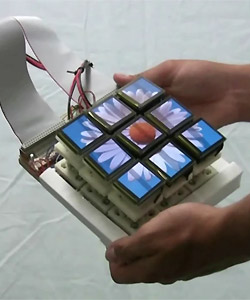Recent Stories
- Businesses urged to tap into science and technology young talent
- Digital relay baton enables remote crowd cheering of athletes
- Health Innovation Campus moves a step closer
- £7.1 million R&D boost for North West businesses
- Centre of excellence created for the next industrial revolution
- Artificial intelligence toolkit spots new child sexual abuse media online
- Strategic partnership set to help plug cyber security skills gap
- What your choice of smartphone says about you
- InfoLabTree: Discover the Story
- novi.digital Launch Event - 'An Event to Help Businesses Grow Online'
RSS Feeds
RSS feeds can deliver the latest InfoLab21 news and events direct to your browser without you having to visit the website.
In most browsers you can click on an RSS link and choose to subscribe to the feed to add it to your favourites or bookmarks.
Lancaster researchers demo 3D screens of the future
Story supplied by LU Press Office
 the display's nine mini-screens each tilt independently of one another and can rise up and down
the display's nine mini-screens each tilt independently of one another and can rise up and down
Researchers at Lancaster University, Bristol University, and Nokia Research have built a prototype 3D display which tilts and moves to reflect the shape of objects appearing on screen - whether they be the contours of a mountainous landscape or the petals of a flower.
The custom-built prototype includes nine mini-screens which each tilt independently of one another and can rise up and down, bringing a whole new layer of information to the viewer.
Although still an early design, the prototype gives users an impression of what the technology could be capable of in future. It has also given researchers chance to gauge public opinion and begin thinking about potential applications - from 3D maps to braille text - and understand how users might interact with such devices.
Lancaster University's Dr Jason Alexander, who helped build the prototype, said: "To me, this is where touch screen technology is going. There is nothing tactile about our current screens, they are flat and uniform which means you have to look at the screen in order to interact with it.
"Tilt displays are a completely new area of human computer interaction, perhaps we won't see products in the shops for another 20 years but one of the reasons we are doing this research is to explore and demonstrate the potential these screens have and to explain to material scientists why it would be worth investing time and money in this area.
"Ultimately you can imagine the kind of effect you would get if each pixel of the screen on your mobile phone, tablet or television was a small square which could move independently of the pixels around it. Maps would come to life in 3D, buttons could appear at your fingertips, characters could rise up from the screen and even photographs would become more like the 3D objects they depict in real life.
"The potential applications are numerous, these examples are just the tip of the iceberg."
Fri 23 November 2012



